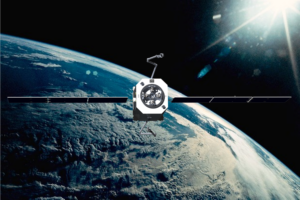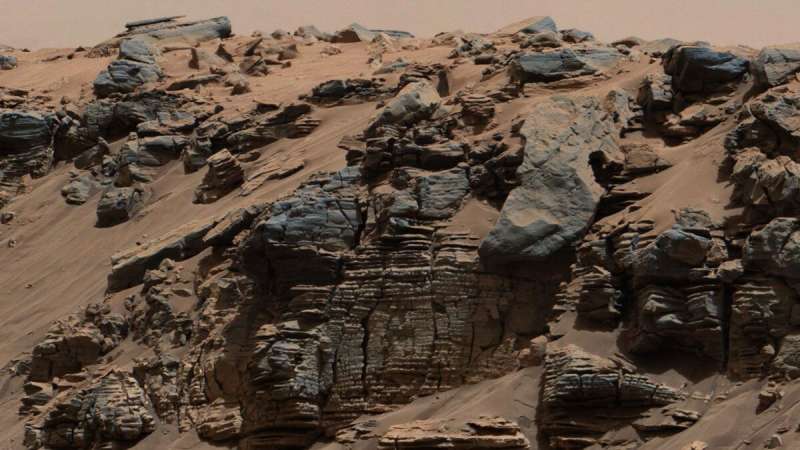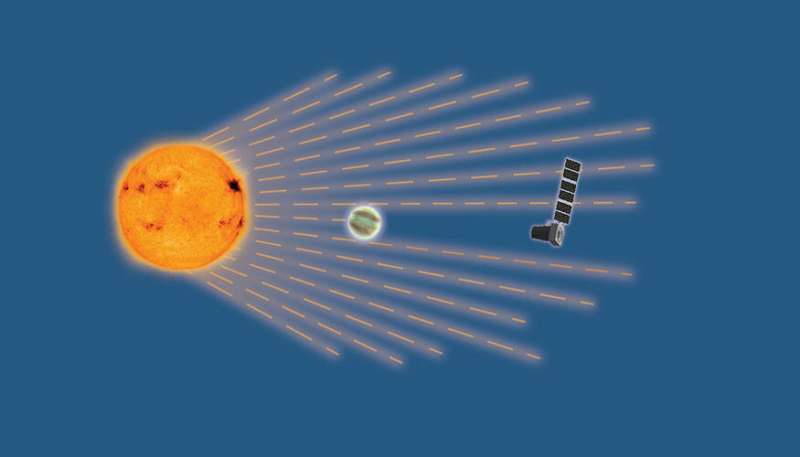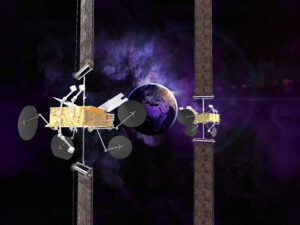Are astronomers seeing a signal from giant black holes?
Thursday, 13 January 2022 05:42 An international team of astronomers has discovered what could be the early sign of a background signal arising from supermassive black holes, observed through low-frequency gravitational waves. These scientists are comparing data collected from several instruments, including the National Science Foundation's Green Bank Telescope (GBT.)
Gravitational Waves ripple through spacetime at a lig
An international team of astronomers has discovered what could be the early sign of a background signal arising from supermassive black holes, observed through low-frequency gravitational waves. These scientists are comparing data collected from several instruments, including the National Science Foundation's Green Bank Telescope (GBT.)
Gravitational Waves ripple through spacetime at a lig Webb Begins Its Months-Long Mirror Alignment
Thursday, 13 January 2022 05:42 Webb has begun the detailed process of fine-tuning its individual optics into one huge, precise telescope.
Engineers first commanded actuators - 126 devices that will move and shape the primary mirror segments, and six devices that will position the secondary mirror - to verify that all are working as expected after launch. The team also commanded actuators that guide Webb's fine steering
Webb has begun the detailed process of fine-tuning its individual optics into one huge, precise telescope.
Engineers first commanded actuators - 126 devices that will move and shape the primary mirror segments, and six devices that will position the secondary mirror - to verify that all are working as expected after launch. The team also commanded actuators that guide Webb's fine steering Vast bubble in interstellar space source of all nearby, young stars
Thursday, 13 January 2022 05:42 The Earth sits in a 1,000-light-year-wide void surrounded by thousands of young stars - but how did those stars form?
In a paper appearing in Nature, astronomers at the Center for Astrophysics | Harvard and Smithsonian (CfA) and the Space Telescope Science Institute (STScI) reconstruct the evolutionary history of our galactic neighborhood, showing how a chain of events beginning 14 million
The Earth sits in a 1,000-light-year-wide void surrounded by thousands of young stars - but how did those stars form?
In a paper appearing in Nature, astronomers at the Center for Astrophysics | Harvard and Smithsonian (CfA) and the Space Telescope Science Institute (STScI) reconstruct the evolutionary history of our galactic neighborhood, showing how a chain of events beginning 14 million Researchers Observe Massive CME on Distant, Sun-Like Star
Thursday, 13 January 2022 05:42 EK Draconis illuminates an unimagined picture of how superflares may affect interplanetary space through coronal mass ejections
Welcome to the New Year! While Earth celebrated 2022's arrival with displays of fireworks, the greatest "fireworks show" in our solar system often occurs on the Sun. Its atmosphere is a venue for dynamic sunspots, solar flares, and dramatic encores of released magnetic
EK Draconis illuminates an unimagined picture of how superflares may affect interplanetary space through coronal mass ejections
Welcome to the New Year! While Earth celebrated 2022's arrival with displays of fireworks, the greatest "fireworks show" in our solar system often occurs on the Sun. Its atmosphere is a venue for dynamic sunspots, solar flares, and dramatic encores of released magnetic North Pole solar eclipse excited auroras on the other side of the world
Thursday, 13 January 2022 05:42 A solar eclipse over the Arctic created changes in auroras in both of Earth's hemispheres due to connections through the planet's magnetic field, according to a new study. The new work could help scientists predict changes in the near-Earth environment that can interfere with satellite communication.
On 10 June 2021, the moon's shadow darkened much of the Earth's northern polar region, pro
A solar eclipse over the Arctic created changes in auroras in both of Earth's hemispheres due to connections through the planet's magnetic field, according to a new study. The new work could help scientists predict changes in the near-Earth environment that can interfere with satellite communication.
On 10 June 2021, the moon's shadow darkened much of the Earth's northern polar region, pro Atomos Space secures funding to develop space tug business
Wednesday, 12 January 2022 23:45
Denver-based startup Atomos Space announced Jan. 12 it has raised the $5 million it had first sought in 2020 to develop its space-tug business, following an investment from early-stage investor Cantos Ventures.
NASA to start astrophysics probe program
Wednesday, 12 January 2022 22:29
NASA is starting to implement recommendations of the astrophysics decadal survey by announcing plans for a new line of missions and laying the groundwork for future large space telescopes.
Pentagon warns hundreds of programs in limbo until Congress passes full-year budget
Wednesday, 12 January 2022 17:45
U.S. military satellite procurements and contracts for launch services have been put on hold and cannot move forward until Congress passes a full-year defense appropriations bill for fiscal year 2022.
Space Force on track to absorb Space Development Agency this fall
Wednesday, 12 January 2022 16:33
The Space Development Agency, created in 2019 as a separate entity under the Office of the Secretary of Defense, will be transferred to the U.S. Space Force in October, the agency’s director confirmed Jan.
China’s megaconstellation project establishes satellite cluster in Chongqing
Wednesday, 12 January 2022 13:55
A group leading China’s national low Earth orbit communications megaconstellation has founded two new firms to help develop the project, but overall plans remain vague.
Machine learning algorithms help scientists explore Mars
Wednesday, 12 January 2022 13:19
NASA's Curiosity rover has been exploring the Red Planet's surface for nearly a decade, with its main mission being to determine whether Mars was once habitable. While the rover's investigations have indeed confirmed that Mars was once a watery world filled with potentially life-sustaining chemistry, there's still much to learn. Curiosity's mountains of data offer an opportunity to use machine learning algorithms to investigate the planet's surface in even more detail.
A new article in Earth and Space Science focuses on the data collected by Curiosity's Chemistry and Camera (ChemCam) instrument package. ChemCam combines two instruments: a laser-induced breakdown spectrometer (LIBS) and a remote micro-imager (RMI) for high-resolution imaging.
Multi-orbit constellation startup Mangata Networks raises $33 million
Wednesday, 12 January 2022 12:42
U.S.-based startup Mangata Networks has raised $33 million from an international mix of investors for its multi-orbit connectivity constellation plans.
Pandora mission to study stars and exoplanets continues toward flight
Wednesday, 12 January 2022 12:25
The Pandora mission, co-led by a national laboratory and a NASA flight center, has passed a crucial step on its path to study stars and planets outside our solar system, or exoplanets.
After a successful concept study report and system requirements review, NASA approved the mission to continue toward flight.
Intelsat orders two flexible GEO satellites for post-bankruptcy growth plan
Wednesday, 12 January 2022 09:01
Intelsat has ordered two software-defined satellites from Thales Alenia Space as the operator edges closer to emerging from bankruptcy.
Astroscale U.S. and Orbit Fab sign first on-orbit satellite fuel sale agreement
Wednesday, 12 January 2022 08:43 Orbit Fab, the Gas Stations in Space refueling service provider and Astroscale U.S. Inc., the U.S. subsidiary of Astroscale Holdings Inc. and market leader in securing long-term orbital sustainability, has announced a commercial agreement to refuel Astroscale's Life Extension In-Orbit (LEXI) Servicer in geostationary orbit (GEO); LEXI is the first satellite designed to be refueled.
Under t
Orbit Fab, the Gas Stations in Space refueling service provider and Astroscale U.S. Inc., the U.S. subsidiary of Astroscale Holdings Inc. and market leader in securing long-term orbital sustainability, has announced a commercial agreement to refuel Astroscale's Life Extension In-Orbit (LEXI) Servicer in geostationary orbit (GEO); LEXI is the first satellite designed to be refueled.
Under t 
